
Guests
- Harry Siegelcolumnist and editorial writer for the New York Daily News. His latest article is “The lonesome death of Eric Garner: When men are treated like pieces of meat by cops and medics, trust erodes.”
While much of the nation has seen the cellphone video showing the New York City police officer’s chokehold that led to Eric Garner’s death, a second video shows what happened after Garner last gasped, “I can’t breathe.” The video shows Garner lying unresponsive on the sidewalk as police and medics do nothing to help him. A bystander can be heard saying, “Why nobody do no CPR?” Eventually they lift his body onto a stretcher. New York Daily News columnist Harry Siegel writes about the video in his latest article, “The lonesome death of Eric Garner: When men are treated like pieces of meat by cops and medics, trust erodes.”
Transcript
AMY GOODMAN: Well, today we’ll be joined by three guests here in New York, and we’ll also be going to Ohio. Harry Siegel is with us, a columnist and editorial writer for the New York Daily News. His latest piece headlined “The lonesome death of Eric Garner: When men are treated like pieces of meat by cops and medics, trust erodes.” Graham Weatherspoon is with us, retired detective with the New York City Police Department, and Mychal Denzel Smith, contributing writer for The Nation and Knobler Fellow at The Nation Institute, his latest piece, “The System That Failed Eric Garner and Michael Brown Cannot Be Reformed.” He was at last night’s protests, as so many were.
But we want to start with Harry Siegel, because of a part of the video that has not been seen as much. We’ve all seen over and over again the horror of Eric Garner being taken down in that chokehold, banned by the police department, and piled on by all of these officers in Staten Island on the sidewalk. But as you write about in your New York Daily News column on Wednesday, “It’s the second Eric Garner video that made me cry. Not the one where Officer Daniel Pantaleo chokes Garner for 15 seconds before smashing his head into the sidewalk for 10 seconds as other cops hold down and cuff Garner, ignoring the pleas he issued with the last air in his lungs: 'I can't breathe.’ … It’s the video shot minutes later as Garner lies dying among men and women in uniforms, men and women who seemed not to give half a damn, that broke me down.” Harry Siegel’s words. He goes on to describe the second video that shows Garner laying unresponsive on the sidewalk after he was put in a chokehold, as police and medics do nothing to help him. Eventually they lift his body onto a stretcher. Then he describes this scene in the video where onlookers question the officers. Listen closely.
ONLOOKER 1: Why nobody do no CPR?
ONLOOKER 2: Nobody doing nothing.
POLICE OFFICER: Because he’s breathing.
ONLOOKER 1: He’s breathing?
POLICE OFFICER: Yeah.
AMY GOODMAN: In this second part of the video—and it goes on to show the EMT, the emergency workers—in the video we’re showing, the camera turns to Officer Pantaleo, who’s in the distance. He notices the video is being taken on a cellphone and shows him waving at the person filming. Harry, talk about this part of the video, the entire scene, including the emergency workers coming.
HARRY SIEGEL: This man is on the ground. He’s unresponsive. He’s on his stomach, which is not procedure when someone’s already been arrested—he’s cuffed. And that’s a way that you can stop someone from being able to breathe, especially a larger guy. There are officers there. Two of them are holding him, but they’re more or less ignoring him. An EMT finally shows up. She sees he has a pulse. She says, and the cops say, “Sir, sir, we’re here to help. Can you respond?” to the EMT—to the unconscious guy on the ground. As you heard, people who are being held in stores, just ordinary Staten Island citizens, are saying, “He can’t breathe.” It’s not that hard to figure out. He’s entirely ignored. Eventually, the two EMTs come back, two medics come back, and a bunch of cops lift Garner, who’s a large man, and plop him onto a gurney.
AMY GOODMAN: What was the comment of the cop as they’re going to pick him up? Something like it will take six men?
HARRY SIEGEL: Actually, it’s five, I believe, counting when they do finally pick him up. And they, “Ugh,” and then drop him from maybe six inches up. One of his legs rolls off. One of the cops is holding the back of his shirt, his T-shirt. Stomach’s out. You know, it looks like he’s about to fall off. The contempt for just this living, breathing human is palpable. It’s—
JUAN GONZÁLEZ: And there’s no attempt at any point by someone to resuscitate him, not even the EMT.
HARRY SIEGEL: No, or to clear his airways or any other part of this. And we’re reporting in the news today, in a significant case that’s gotten a little less attention at this point, the Akai Gurley in the Pink House shootings, that the officer who, it looks like, accidentally shot him, that after they did that, the reason there’s this long delay is that they went and called their union rep before they called 911.
AMY GOODMAN: Wait, can you—you’ve got to tell this more. Because all the attention is on Eric Garner, Akai Gurley—
HARRY SIEGEL: Forgive me.
AMY GOODMAN: —hasn’t gotten as much attention. But why don’t you explain what happened? In the midst of all of this, right before actually the Ferguson verdict—or, decision of the grand jury came down, explain what happened in New York.
HARRY SIEGEL: Two rookie police officers, although older, are doing a vertical patrol, which is when you’re in a public housing building and you go up to the roofs to make sure nothing bad is happening there, and you check the stairwells. These are considered dangerous assignments. They often make cops nervous. It’s not great to have two rookies doing this.
They go off the roof and into a stairwell. It’s dark, which it shouldn’t be. The light is off. The light a floor below is off. One of them takes out his gun, which is a matter of officer discretion by New York policy, which is its own very serious problem. They open the door. A floor down, a young man, with his—I believe his girlfriend, opens the door, a 28-year-old man.
Somehow the officer’s gun goes off, and he ends up dead. He doesn’t realize he’s shot right away. He runs down the stairs, Akai Gurley. The police officers run back upstairs. They’ve shot. Maybe they’re scared now of what they’ve done. Maybe they don’t understand quite what’s happening, and there’s an echo. But they don’t go and try to resuscitate this man or find out what happened.
And we’re finding out today, the news is reporting, that the first thing they do is call their union reps. And help finally arrives, and only because one of the neighbors calls 911. After these two officers—it doesn’t appear with any ill intent, just the sort of sloppiness where you have your gun out and you shoot and you think you might have hit someone, and your first concern is, “Oh, no, what have I done to my life?” run upstairs and call their union—not 911, don’t try to help the man. And that is—
JUAN GONZÁLEZ: And there are also now indications that they weren’t even supposed to be on a vertical patrol—
HARRY SIEGEL: Yes.
JUAN GONZÁLEZ: —that they had been told not to be on a vertical patrol, as well.
HARRY SIEGEL: Yes, which would—I can’t even wrap my mind around that.
AMY GOODMAN: And this also goes to public housing, that the elevator wasn’t working, which is why Akai went into the stairwell to walk down with his girlfriend—
HARRY SIEGEL: Yes.
AMY GOODMAN: —also the father of a two-year-old, and the fact that the cops went into this dark stairwell and ended up shooting the gun.
HARRY SIEGEL: And the night-shift buildings, at 4:30, the staff pretty much goes. So, if there’s a light out and they haven’t dealt with it at that point—and, you know, bear in mind, people work, they come home maybe at 6:00, they’re in buildings where the elevators don’t always work, and suddenly just going up or down is a tremendous danger. And the police officers who are there, especially younger ones, they’re scared. And they’re scared of ordinary people who are using the stairs. And it’s a recipe for this sort of disaster to happen. And unfortunately, it just has. And this man, who had done nothing of any sort wrong, just opened a door, is dead. But to me, as with Garner, the contempt afterward—you know, there’s this moment of violence, and then someone is hurt, and you have officers who are not responding like another human being has been hurt—is what’s heartbreaking.
JUAN GONZÁLEZ: And, of course—
HARRY SIEGEL: Most heartbreaking.
JUAN GONZÁLEZ: —the line that connects all of this, if you go to the Michael Brown case, after Michael Brown is shot, he is left for hours and hours on the street right there in front of not only his relatives and all of his neighbors, again, in a disregard for the basic humanity of a person.
AMY GOODMAN: And in the case of Garner, the police are shouting at the onlookers. They’re saying, “Give him space. Give him space.” And one of the women who’s standing next to Ramsey Orta, the one who filmed the cellphone, clearly, because her voice is right next to him, she’s saying, “Oh, now you’re saying give him space, when you’re the ones who took him down. Where are the EMTs? Where’s the emergency workers?” she was shouting.
HARRY SIEGEL: That’s right, and everything that they’re saying is right [inaudible]—
AMY GOODMAN: They were saying, “Why don’t you give him CPR?” That’s what she was saying.
HARRY SIEGEL: Yes. And they’re saying, “Back up. Back up.” You know, they’re controlling the perimeter. “He needs air.” But they’re not doing anything to help this man breathe or determine if he needs that help. They’re just letting him lie there. And he doesn’t die on the ground. They put him in an ambulance, and he has a heart attack there and then dies. Like, after this chokehold, after that whole part of things, there’s a very decent chance that his life could have been saved if he had just been thought of as a full human being.
AMY GOODMAN: We’re going to talk about this right after the break. Harry Siegel, columnist and editorial writer for the New York Daily News. Juan González, co-host on Democracy Now!, also a columnist at the New York Daily News. When we come back, Mychal Denzel Smith, with The Nation, and Graham Weatherspoon, a retired detective with the New York Police Department. This is Democracy Now! Back in a minute.

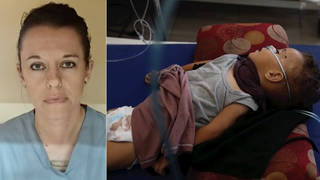
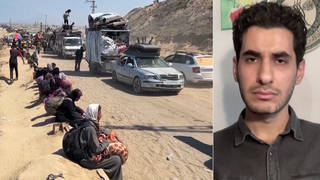
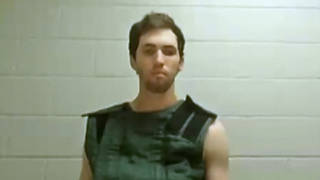
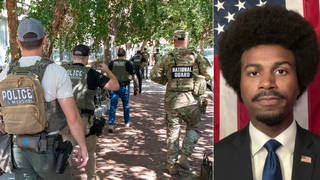
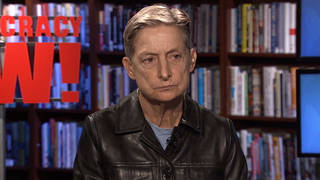
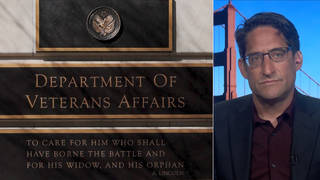
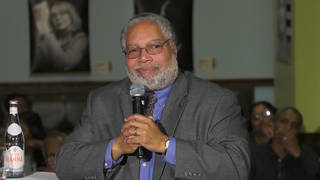


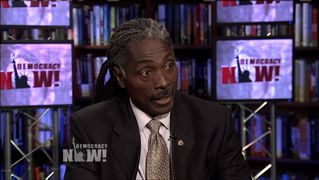

Media Options